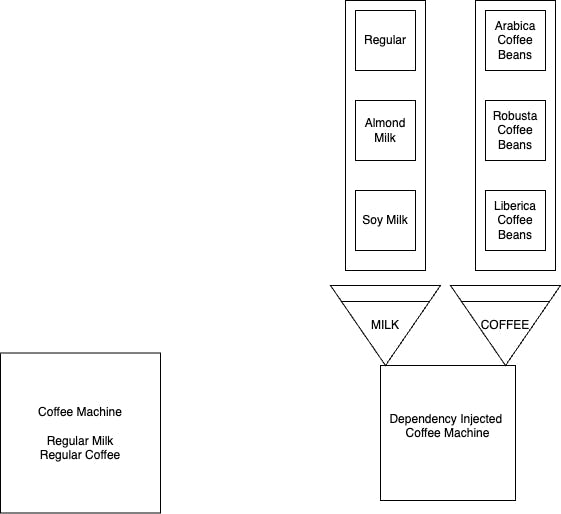
Photo by James Harrison on Unsplash
The Dependency Injection Magic: Unlocking the Secret to Supercharged Code!
Introduction
One of the things that I learned in my initial months as a software engineer was the importance of writing clean and scaleable. A thoughtfully structured codebase facilitates swift adaptation to evolving product/software requirements, enabling efficient code modifications as needed over time.
Python is a fantastic language for writing software (the preferred choice for beginner programmers), but as the codebase becomes bigger and more complex, we need a way to organize the code and manage these dependencies. That's where Dependency Injection shines!
Real-world scenario: Ordering Coffee
Imagine you are a barista (the person who makes coffee) at a cozy coffee shop. You have to prepare different types of coffee for customers. Each coffee requires a different type of milk: regular milk, almond milk, or soy milk. Your coffee machine is like your program, and the milk is a dependency.

Without Dependency Injection:
- No Dependency Injection: In this scenario, you probably don't have the option to switch the type of milk or the type of coffee as per the customer's request. Your machine can only produce one type of coffee.
With Dependency Injection:
Dependency Injection: Now, let's use Dependency Injection to make your life easier.
You have a "milk provider" helper. This helper's job is to bring you the right type of milk when you need it.
When the customer orders a latte with almond milk, you simply tell your milk provider, "I need almond milk."
The milk provider brings you almond milk, and you can use it to make the latte.
If another customer orders a cappuccino with regular milk, you just tell your milk provider, "I need regular milk," and it brings you that.
In programming, Dependency Injection works similarly. Instead of fetching or managing dependencies (like databases, external services, or other code pieces) manually in your code, you have a system or framework (the "dependency injector") that provides them when needed. This makes your code cleaner, easier to maintain, and less error-prone, just like the coffee-making process becomes smoother with Dependency Injection.
Understanding dependencies

Well, any building block of a program is dependent on some other building block to work properly. Dependencies are like the puzzle pieces that make up a complete picture. Imagine you're building a massive LEGO castle. Each brick is like a part of your program, and they all need to fit together perfectly.
Examples
Your business logic is dependent on the database to store data
Your game is dependent on a graphics library to display images and animations.
Your navigation app is dependent on GPS to provide accurate location information.
Your e-commerce website is dependent on a payment gateway (vendors) to process online transactions.
Need for dependency injection
Decoupling:
- Dependency injection decouples the high-level modules or classes from their low-level dependencies. This separation makes it easier to modify or replace individual components without affecting the entire system.
Testability:
- By injecting dependencies, you can easily replace real dependencies with mock objects or stubs during testing. This makes unit testing more straightforward and enables you to isolate the code you're testing, ensuring that changes don't introduce unexpected issues.
Reusability:
- Code with injected dependencies is often more reusable because it doesn't rely on concrete implementations of its dependencies. Instead, it depends on abstractions (e.g., interfaces or abstract classes), allowing you to provide different implementations as needed.
Flexibility:
- Dependency injection enables you to change the behavior of a class or module by simply changing the injected dependency. This flexibility is especially valuable when adapting to evolving requirements or integrating with various external systems.
Maintainability:
- Code that uses dependency injection is typically easier to maintain because it adheres to the Single Responsibility Principle (SRP) and the Open/Closed Principle (OCP) of the SOLID principles. This results in smaller, more focused classes that are easier to understand and modify.
Readability:
- Dependency injection makes the dependencies of a class explicit, improving code readability. Developers can quickly see what other components a class relies on, making it easier to comprehend the overall system architecture.
Reversal of Control (IoC):
- Dependency injection is a form of Inversion of Control (IoC), where the control over the creation and management of dependencies is shifted from the dependent class to an external source (e.g., a container or factory). This inversion promotes a more flexible and extensible design.
Parallel Development:
- In a team environment, dependency injection allows multiple developers to work on different parts of a system concurrently. Since the dependencies are well-defined and injected, there is less risk of conflicts and integration issues.
Test-Driven Development (TDD):
- Dependency injection is conducive to Test-Driven Development (TDD) practices. It encourages the creation of interfaces and abstractions upfront, making it easier to write tests before implementing the actual code.
Better Error Handling:
- With dependency injection, error handling becomes more straightforward. You can isolate the error-prone components and replace them with error-handling implementations or loggers without affecting the entire application.
Dependency injection in Action
1. Without Dependency Injection (Complex Version):
# Step 1: Without Dependency Injection
class CoffeeMachine:
def __init__(self, coffee_type, milk_type):
self.coffee_type = coffee_type
self.milk_type = milk_type
def make_coffee(self):
if self.coffee_type == "Robusta":
coffee = "Robusta Coffee"
elif self.coffee_type == "Liberica":
coffee = "Liberica Coffee"
elif self.coffee_type == "Excelsa":
coffee = "Excelsa Coffee"
elif self.coffee_type == "Arabica":
coffee = "Arabica Coffee"
if self.milk_type == "almond":
milk = "Almond Milk"
elif self.milk_type == "soy":
milk = "Soy Milk"
elif self.milk_type == "regular":
milk = "Regular Milk"
elif self.milk_type == "no milk":
milk = "No Milk"
return f"Here's your {coffee} with {milk}."
# Usage
coffee_machine = CoffeeMachine("Arabica", "almond")
print(coffee_machine.make_coffee())
2. With Dependency Injection (Using Classes and Objects):
# Step 2: With Dependency Injection (Using Classes and Objects)
class Coffee:
def __init__(self, coffee_type):
self.coffee_type = coffee_type
def get_coffee(self):
return f"{self.coffee_type} Coffee"
class Milk:
def __init__(self, milk_type):
self.milk_type = milk_type
def get_milk(self):
return f"{self.milk_type} Milk"
class CoffeeMachine:
def __init__(self, coffee, milk):
self.coffee = coffee
self.milk = milk
def make_coffee(self):
coffee = self.coffee.get_coffee()
milk = self.milk.get_milk()
return f"Here's your {coffee} with {milk}."
# Usage
arabica = Coffee("Arabica")
almond_milk = Milk("Almond")
coffee_machine = CoffeeMachine(arabica, almond_milk)
print(coffee_machine.make_coffee())
3. Adding Interfaces and Factories
# Adding interfaces and factories
class CoffeeInterface:
def get_type(self):
pass
class MilkInterface:
def get_type(self):
pass
class RobustaCoffee(CoffeeInterface):
def get_type(self):
return "Robusta"
class AlmondMilk(MilkInterface):
def get_type(self):
return "almond"
class CoffeeMachine:
def __init__(self):
self.milk = None
self.coffee = None
def choose_milk(self, milk):
self.milk = milk
def choose_coffee(self, coffee):
self.coffee = coffee
def make_coffee(self):
if self.milk and self.coffee:
return f"Making {self.coffee.get_type()} coffee with {self.milk.get_type()} milk."
else:
return "Please choose coffee and milk types."
# Example usage
machine = CoffeeMachine()
coffee = RobustaCoffee()
milk = AlmondMilk()
machine.choose_coffee(coffee)
machine.choose_milk(milk)
print(machine.make_coffee())
4. Using the Python Dependency Injector Library:
To use the Python Dependency Injector library, you would first need to install it (pip install dependency-injector) and then use the @inject decorator to define dependencies. Here's a simplified example
# Step 4: Using the Python Dependency Injector Library
from dependency_injector import containers, providers, inject
class Coffee:
def __init__(self, coffee_type):
self.coffee_type = coffee_type
def get_coffee(self):
return f"{self.coffee_type} Coffee"
class Milk:
def __init__(self, milk_type):
self.milk_type = milk_type
def get_milk(self):
return f"{self.milk_type} Milk"
@inject
class CoffeeMachine:
def __init__(self, coffee: Coffee, milk: Milk):
self.coffee = coffee
self.milk = milk
def make_coffee(self):
coffee = self.coffee.get_coffee()
milk = self.milk.get_milk()
return f"Here's your {coffee} with {milk}."
# Dependency Injection Container
class CoffeeContainer(containers.DeclarativeContainer):
arabica = providers.Singleton(Coffee, coffee_type="Arabica")
almond_milk = providers.Singleton(Milk, milk_type="Almond")
# Usage
coffee_container = CoffeeContainer()
coffee_machine = coffee_container.CoffeeMachine()
print(coffee_machine.make_coffee())
Testing with Dependency Injection
Testing with Dependency Injection is a crucial aspect of software development, and it significantly simplifies unit testing in Python. Dependency Injection (DI) provides a mechanism for substituting real dependencies with mock objects or stubs during testing. This process ensures that unit tests focus on isolating the specific component being tested, making it easier to verify its functionality without worrying about the behavior of its dependencies.
One of the key advantages of using Dependency Injection for testing in Python is that it allows you to write test cases with injected dependencies. Here's how DI simplifies unit testing:
Isolation of Components: With Dependency Injection, you can easily replace real dependencies with test-specific implementations. For example, if your code relies on a database connection, you can inject a mock database connection that simulates the behavior of a real database without actually making network calls or modifying data.
Predictable Testing: By injecting controlled dependencies, you ensure that your tests produce consistent and predictable results. This predictability is crucial for writing reliable and reproducible unit tests.
Faster Test Execution: Real dependencies might introduce network latency or require complex setup procedures. Injecting mock dependencies eliminates these overheads, resulting in faster test execution, which is especially valuable when running a large suite of tests.
Focused Testing: Dependency Injection encourages writing unit tests that focus on a specific component or class, adhering to the principle of testing one thing at a time. This focused approach makes it easier to identify and fix issues.
Reduced Test Maintenance: As your codebase evolves, the behavior of dependencies may change. With DI, you only need to update the mock implementations of the dependencies in your test cases, keeping your tests aligned with the current codebase.
Here's a simplified example of how Dependency Injection can be used in Python unit testing:
# Original Class with Dependency
class DataService:
def __init__(self, database):
self.database = database
def get_data(self, query):
return self.database.execute(query)
# Test Class with Mocked Dependency
class MockDatabase:
def execute(self, query):
# Simulate database behavior for testing
if query == "SELECT * FROM users":
return [{"id": 1, "name": "Alice"}, {"id": 2, "name": "Bob"}]
else:
return []
# Unit Test with Dependency Injection
def test_data_service():
# Inject the mock database
data_service = DataService(MockDatabase())
# Test the DataService using the mock database
result = data_service.get_data("SELECT * FROM users")
# Assert the expected result
assert result == [{"id": 1, "name": "Alice"}, {"id": 2, "name": "Bob"}]
Conclusion
In conclusion, Dependency Injection is a powerful and essential concept in software development that promotes code organization, maintainability, and flexibility. We've seen how it decouples high-level modules from their dependencies, enhances testability, promotes reusability, and provides the flexibility needed to adapt to changing requirements.
Whether you choose to implement Dependency Injection using classes and objects, interfaces and factories, or rely on libraries like Python's Dependency Injector, the fundamental goal remains the same: to create code that's not only efficient but also adaptable to the dynamic nature of software development. So, embrace Dependency Injection as a valuable tool in your coding arsenal to build robust, scalable, and maintainable software solutions.
Articles and Blogs:
Martin Fowler's Article on Dependency Injection - A classic article by Martin Fowler that explains the concept of DI and its benefits.
https://python-dependency-injector.ets-labs.org/introduction/di_in_python.html
Python DI Frameworks and Tools:
Dependency Injector - A popular DI framework for Python that offers a wide range of features for managing dependencies.
Inject - A lightweight and easy-to-use dependency injection library for Python.

